Passport to the Future
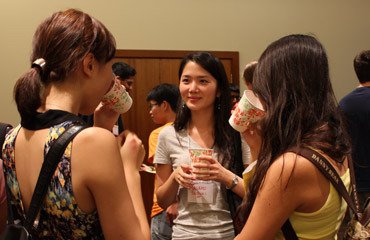
Students from countries on six continents recently descended on Swarthmore's campus armed with passports, luggage, jetlag, and ambitious plans for their future college careers. Representing Australia, Brazil, Canada, China, Costa Rica, Egypt, France, Ghana, Great Britain, Guatemala, Hong Kong, India, Italy, Japan, South Korea, Myanmar, Malaysia, Nepal, Pakistan, Palestine, Singapore, and Vietnam, these 33 international citizens comprise nine percent of Swarthmore's newest class. Joining them for orientation are also American students who live abroad.
"International" is hardly an adequate description of the students who attend the orientation held five days before the rest of the first-year students arrive. In fact, being an "international student" has more dimensions than simply being from overseas. Some students are from multiple heritages, spent time growing up in multiple countries, or attended international schools. Raundi Quevedo, for example, has a Peruvian father, an American mother, and was born and raised in France, while Seung Moon Lee was raised in Seoul, Korea, but holds a Canadian passport. As a result, the international student body is an eclectic mix of languages, cultural and ethnic backgrounds, and accents.
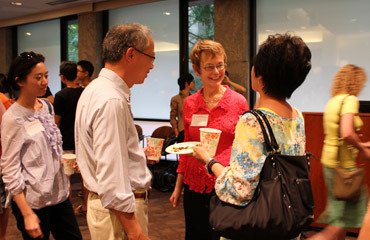
During the first day of the orientation, students met at the Kohlberg Coffee Bar and shared travel stories, both exciting and taxing. Quevedo and Constance Mietkowski, both from the same high school in France, traveled together from Paris to New York, where they toured the city before coming to Swarthmore. In contrast, Chien Wong's trip to Philadelphia from Hong Kong ultimately took him 18 hours. But at the end of a grueling experience, he arrived in time to see the sunrise on the way and reached campus at 7 a.m. during a beautiful, calm morning.
While introducing themselves, students shared stories about how they spent their summer (or winter, if from the Southern hemisphere), before coming to campus. Htet Win, from Yangon, Burma, tutored a hearing-impaired student, while Aaron Kroeber, an American who grew up in Beijing, walked across the Hungary-Romania border. Some attended local high schools while others attended schools that offer internationally recognized curricula. Liting Chen attended one of her high school's three campuses in China and had 1,900 students in her graduating class. "We had so many people," Chen says, "we actually didn't have many chances to talk to each other and to get help from each other." Chen adds she is looking forward to being a part of a smaller community and getting to better know her peers and professors.
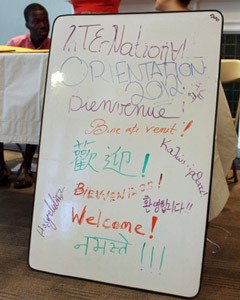
Much of the orientation and welcoming of new students involves food, which seems to transcend differences in language, culture, and background. This year, students ate an American-style barbeque in Wharton Courtyard. The dinner was spearheaded by student orientation leaders who were themselves unfamiliar with barbeques. As a result, they filled the grill with almost 12 pounds of charcoal pretreated with lighter fluid.
It was more than sufficient. Despite more closely resembling a bonfire, the flames eventually mellowed and orientation leaders were able to successfully serve an outdoor dinner of hot dogs, beef and veggie burgers, and salads and brownies shaded by the trees in the courtyard. However, as Stephanie Kestelman from São Paulo, Brazil, noted "barbeque" is somewhat of a misnomer. Kestelman is a connoisseur of churrassco, a Brazilian style spit-roasted meat. "Barbeque isn't burgers!" she proclaims.
As students got acclimated to life at Swarthmore, student orientation leaders also took them to Philadelphia. In addition to walking through Center City, visiting the Liberty Bell, and dining on South Street, this year students also toured the iconic Love Park, enjoyed snacks from Reading Terminal Market, and stopped for bubble tea in Chinatown. The cheesesteak, perhaps Philadelphia's most recognized food item, sparked the curiosity of some students, while others happily passed on American food for dishes at nearby Turkish and Vietnamese restaurants.
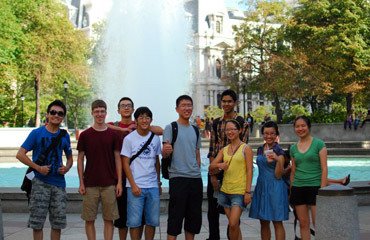
On Monday, students participated in a mixer in Upper Tarble over a catered Ethiopian lunch. Joining them were incoming domestic first-years who participated in the Tri-Co Institute. The students discussed the differences international students experience in attending college abroad, including delays in obtaining student visas.
Shaina Lu '16, from Kenner, La., empathized, imagining that procedures at an embassy would be similar to the delays Americans face at the Department of Motor Vehicles, only worse. Hailing from a state that is five hours away by plane, Lu was also sympathetic to the international students' distance from home. "I guess you can't go home for Thanksgiving," she said, moments before realizing that international students do not celebrate the holiday.
International orientation came to a close as the rest of the first-year students arrived on campus. The final day is bittersweet, as students who have forged new friendships are due to be separated into different all-campus orientation groups. But they are excited to expand their networks to the rest of the campus.
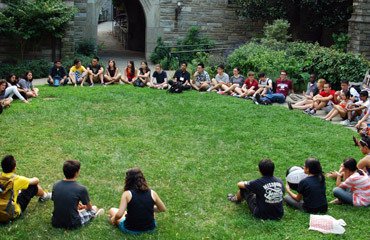
"There's a part of me that feels relieved that it's over because we worked a lot," says student orientation organizer Ximena Anleu '15, co-president of i20, the international student club. At the same time, she says she feels a sense of satisfaction from positively influencing the arrival of the incoming international students.


